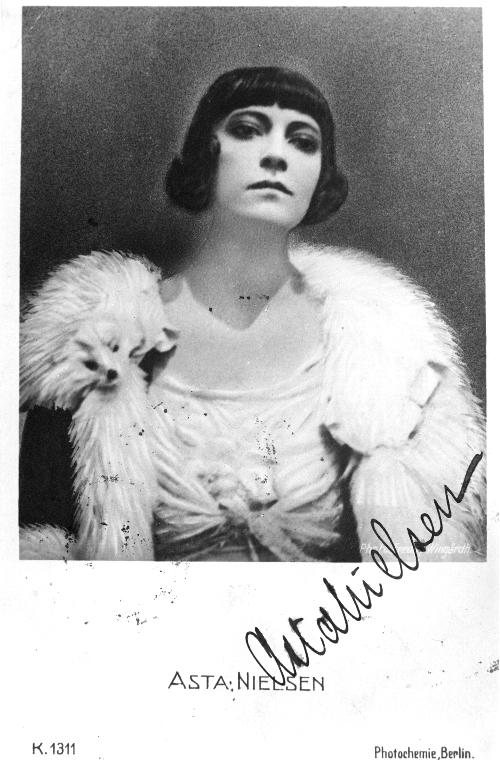by
Julie Allen
Frequently lauded as “die Duse des Kinos” [the Duse of the cinema], as Poul Elsner noted in Weltrundschau in 1911 (517), the Danish actress Asta Nielsen was the first major star of German silent film. She acted in more than seventy films, all but four of them made with German production companies, during the twenty-two years of her film career. The phenomenal success of her debut film, Afgrunden/The Abyss (1910) enabled her to become the first global film star under the new monopoly distribution system. From 1910 to 1914, she collaborated closely with director Urban Gad, who was also her first husband, under the auspices of Deutsche Bioscop and Projektions-AG “Union” (PAGU), and later established two film companies of her own. Although she struggled to come to terms with the director-centric turn of the film industry in Germany in the 1920s that restricted the artistic autonomy she had enjoyed in the 1910s, she made several of her most artistically impressive films, including several Weimar street films, during this period. In 1932, she acted in her only sound film, Unmögliche Liebe/Impossible Love, which was also her final film, aside from two documentaries about her made decades later.
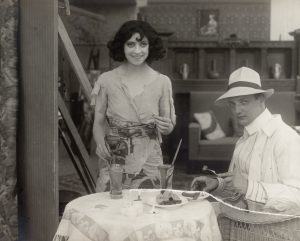
Publicity photo of Asta Nielsen and Urban Gad on set in Berlin. Courtesy of the Danish Film Institute.
Nielsen’s path to film was as unlikely as it was dramatic. She was born in Copenhagen in 1881, the second child of an impoverished working-class Danish couple, Jens Christian and Ida Frederikke Nielsen. She spent seven years of her early childhood in Malmö, Sweden, before returning to Copenhagen, where her father died shortly before Asta’s fourteenth birthday. Biographer Poul Malmkjær notes that her mother hoped that Asta would become a shop attendant (38), but she dreamed of the theatre. In 1899, her striking tenor voice attracted the attention of actor Peter Jerndorff, who arranged for her to have free acting, elocution, and dancing lessons. On Jerndorff’s recommendation, Nielsen was offered a position at the Danish Royal Theater in the fall of 1900, but the birth of her illegitimate daughter Jesta, likely fathered by Jerndorff, in July 1901 caused her to lose both her voice and her position at the Royal Theater. During the next decade, she attempted repeatedly to break into the Copenhagen theatre world, acting in minor roles at the Dagmar Theater and in provincial touring troupes, but without notable success.
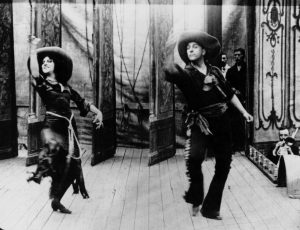
Asta Nielsen and Poul Reumert performing in Afgruden (1910). Courtesy of the Danish Film Institute.
Nielsen’s cinema debut, Afgrunden, was a collaboration with screenwriter/director Gad made on a minuscule budget over the course of a single week that came about almost accidentally as a last-ditch attempt to raise her profile in the Copenhagen acting world, but when it premiered in Copenhagen on September 12, 1910, it became an overnight international sensation. Afgrunden was one of the earliest and most successful Danish erotic melodramas, an extremely profitable genre throughout Europe between 1910 and 1915. The film’s plot line is high melodrama: Nielsen’s character, the respectable bourgeois music teacher Magda Vang, becomes engaged to a pastor’s son but runs away instead with a circus cowboy named Rudolph, who cheats on her with other women, forces her to play piano in cafés to support his drinking habit, and ultimately tries to extort money from her abandoned fiancé. When she protests, Rudolph tries to strangle her, forcing Magda to stab him to death with a table knife. The final scene of the film shows a dazed, dry-eyed Magda being led away by the police. Nielsen’s minimalistic acting style, particularly evident in the memorable final scene, contrasted sharply with the histrionics of other early film actresses, while her remarkably expressive eyes and provocative but restrained sensuality, which featured prominently in the film’s extended erotic gaucho dance sequence, enraptured audiences and critics alike. In 1924, the Hungarian-born film commentator and theorist Béla Balázs described the subtlety of Nielsen’s sexual appeal:
She is never undressed, she does not show her thighs like Anita Berber…, and yet this dancing harlot could take lessons from Asta Nielsen. Her belly dancing is tame compared to Asta Nielsen fully dressed. … [Asta Nielsen’s] spiritualized eroticism is demonically dangerous, since it works at a distance through all of her clothes (162).
After spending a decade struggling to make her name in the Danish theater world, Nielsen suddenly became an international celebrity.
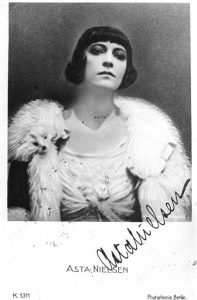
Asta Nielsen. Private Collection.
Nielsen was recruited to work in the German film industry, where she soon became one of the most successful and aggressively marketed film stars of the period. Danish journalist Adolf Langsted reported in 1916, “Jeg sad i Paris og saa Filmens Stjerne stige: med Undren opdagede jeg at den var—dansk. Den første Filmskuespillerinde til at opnaa Verdensry var Asta Nielsen” [Trans.: I sat in Paris and saw film’s star rise: with wonder I discovered that it was—Danish. The first film actress to attain world renown was Asta Nielsen] (11). In an era when actors and actresses were rarely credited on-screen for their roles, Nielsen’s global fame and the commercial success of her films gave her the necessary leverage to demand an active role in the production of her own films. In the summer of 1911, Austrian film distributor Christoph Mülleneisen orchestrated an agreement among several German film production companies, including Paul Davidson’s Projektions-AG Union (PAGU) and Carl Schleussner’s Deutsche Bioscop, to establish a new monopoly distribution company, Internationale Film-Vertriebs-GmbH, based in Vienna and headed by Davidson, which would distribute thirty-two Asta-Nielsen films over the next four years. Historian Andreas Hansert documents that Nielsen agreed, in exchange for an annual salary of 80,000 German marks, 33.3% of the revenues generated by her films, full artistic freedom in choosing her screenplays, costumes, and supporting actors, and, perhaps most importantly, the right to be directed exclusively by her soon-to-be husband Gad (48).
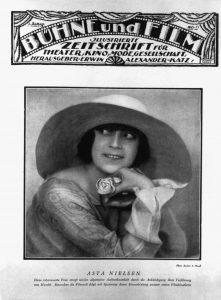
Asta Nielsen. Courtesy of the Deutsches Kinemathek.
As a result of these favourable contractual terms, Nielsen was able to be intimately involved in the creation of both her films and her public persona, unlike many Hollywood stars whose image was dictated by the studios. Working closely with Gad on each year’s Asta Nielsen Series, a collection of eight to ten films that had been pre-sold to distributors around the globe, Nielsen exercised a degree of control over her work on an artistic, technical, and economic level that was extraordinary for a woman at the time. Heide Schlüpmann explains, “Under the sign of the Asta Nielsen series, Nielsen worked with a producer and director in a contractually secured constellation in which all of the freedom was hers” (2012, 47). Some of this freedom may have been due to her close, collaborative relationship with Gad, with whom she made the majority of her (and his) most commercially successful films over a four-year period. Although, as Stephan Michael Schroeder documents, Gad provided detailed scripts for his wife’s roles, Nielsen claimed primary credit for the films she made with Gad (194). Gad is credited as both director and screenwriter on most of their joint films, but Nielsen, in an interview with Danish film historian Marguerite Engberg, described his scripts as partially-completed canvases that left her considerable room for improvisation and dismissed his contribution as primarily concerned with “coming up with good roles for me” (8).
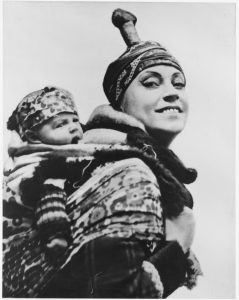
Asta Nielsen as Ivigtut in Das Eskimobaby (1918). Courtesy of the Danish Film Institute.
In her memoirs, Den tiende Muse [The Silent/Tenth Muse], which have not been translated into or published in English, Nielsen claimed to have had a hand in the pre- and post-production phases of her early films, from choosing the screenplays and making her own costumes to splicing the negatives and helping to market the final product, much like her character in Die Filmprimadonna (1913) (Nielsen 1945-46). During World War I, Nielsen parted ways with Gad and formed her own Berlin-based production company, Neutral-Film GmbH. The films Nielsen made with Neutral, including Das Eskimobaby/The Eskimo Baby (1918), and Die Börsenkönigin/ Queen of the Stock Market (1916) are clever and bold, but their circulation was limited by wartime conditions. Many were not released until 1918 and several of the original negatives were later destroyed in a warehouse fire in Berlin. After the war, in 1920, she launched another production company in Berlin, Art-Film GmbH, under whose auspices she made such ground-breaking films as Hamlet (1921), in which she plays a cross-dressing female Hamlet.
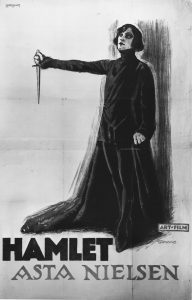
Publicity poster for Hamlet (1921). Courtesy of the Danish Film Institute.
The increasingly director-centric production conditions in Germany after 1918 meant that Nielsen could no longer exercise the same degree of influence over her films as before the war. As her highly publicized disagreement with Ernst Lubitsch over the making of Rausch/Intoxication (1919) reveals, she refused to accommodate directors’ insistence on their complete artistic control over the films they made. She continued making films in Berlin until 1932, including such critically-acclaimed Weimar street films as Die freudlose Gasse/ The Joyless Street (1925) and Dirnentragödie/A Tragedy of the Streets (1927), in both of which she played an aging prostitute, but she found herself increasingly excluded from the off-screen elements of filmmaking she had once handled with such finesse. She returned to Denmark in 1937, where she lived in quiet obscurity as “Fru Nielsen”—except for a sensational love match at the age of eighty-eight with an art dealer eighteen years her junior that made headlines across Germany and Denmark—until her death in Copenhagen in 1972.
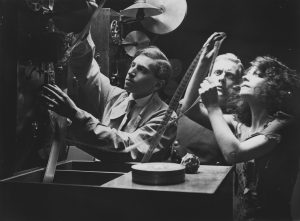
Asta Nielsen, Die Filmprimadonna (1913). Courtesy of Filmarchiv Austria.
Bibliography
Allen, Julie. Icons of Danish Modernity: Georg Brandes & Asta Nielsen. Seattle: University of Washington Press, 2012.
Balázs, Béla. Der Sichtbare Mensch oder die Kultur des Films. Vienna: Deutsch-Österreichischer Verlag, 1924.
Diaz, Pablo. Asta Nielsen. Eine Biographie unserer populären Künstlerin. Translated from Spanish. Berlin: Verlag der Lichtbild-Bühne, 1927.
Elsner, Poul. “Die Duse des Films.” Weltrundschau (1911): 517.
Engberg, Marguerite. Asta Nielsen. Copenhagen: Danish Film Institute, 1966.
Gramann, Karola and Heide Schlüpmann, eds. Nachtfalter. Asta Nielsen, ihre Filme. Vienna: Verlag Filmarchiv Austria, 2009.
Hansert, Andreas. Asta Nielsen und die Filmstadt Babelsberg, Das Engagement Carl Schleussners in der Deutschen Filmindustrie. Petersburg, Germany: Michael Imhof Verlag, 2007.
Howard, Tony. Women as Hamlet. Performance and Interpretation in Theatre, Film and Fiction. Cambridge: Cambridge University Press, 2007.
Langsted, Adolf. Asta Nielsen. Copenhagen: Nyt Nordisk Forlag, 1918.
Loiperdinger, Martin and Uli Jung, eds. Importing Asta Nielsen. The International Film Star in the Making 1910-1914. KINtop 2. New Barnet, UK: John Libbey, 2013.
Malmkjær, Poul. Asta. Mennesket, myten, og filmstjernen. Copenhagen: P. Haase & Son, 2000.
Nielsen, Asta. Den tiende Muse. 2 vols. Copenhagen: Gyldendal, 1945-1946.
Schlüpmann, Heide. “27 May 1911: Asta Nielsen Secures Unprecedented Artistic Control.” In A New History of German Cinema. Eds. Jennifer M. Kapczynski and Michael D. Richardson. Rochester, NY: Camden House, 2012. 44-50.
Schlüpmann, Heide, Eric de Kuyper, Karola Gramann, Sabine Nessel, and Michael Wedel, eds. Unmögliche Liebe. Asta Nielsen, ihr Kino. Vienna: Verlag Filmarchiv Austria, 2009.
Schroeder, Stephan Michael. “Und Urban Gad? Zur Frage der Autorschaft in den Filmen bis 1914.” In Unmögliche Liebe. Asta Nielsen, ihr Kino. Vienna: Verlag Filmarchiv Austria, 2009. 194-210.
Tind, Eva. Astas skygge. Copenhagen: Gyldendal, 2015.
Archival Paper Collections:
Asta Nielsen Collection. Danish Film Institute.
Importing Asta Nielsen Database [online database], Deutsches Filminstitut.
Filmography
A. Archival Filmography: Extant Film Titles:
1. Asta Nielsen as Actress
Afgrunden. Dir/sc.: Urban Gad (Kosmorama Denmark 1910) cas.: Asta Nielsen, Poul Reumert, Emilie Sannom, Oscar Stribolt, Robert Dinesen, si, b&w, 16 & 35mm, 2,532 ft. Archive: Bundesarchiv-Filmarchiv, Svenska Filminstitutet , Danske Filminstitut, Münchner Stadtmuseum, Museum of Modern Art, BFI National Archive, UC Berkeley Art Museum & Pacific Film Archive, Österreichisches Filmmuseum, EYE Filmmuseum.
Den sorte Drøm. Dir./sc.: Urban Gad (Fotorama Denmark 1911) cas: Asta Nielsen, Valdemar Psilander, Gunnar Helsengreen, si, b&w, 35mm, 4,143 ft. Archive: Danske Filminstitut, Lobster Films.
In dem grossen Augenblick. Dir./sc.: Urban Gad (Deutsche Bioscop for Projektions AG “Union” [PAGU] Germany 1911) cas.: Asta Nielsen, Max Obal, Eugenie Werner, Emil Albes, Hugo Flink, si, b&w, 35mm, 3,904 ft. Archive: Danske Filminstitut, George Eastman Museum, EYE Filmmuseum.
Balletdanserinden. Dir.: August Blom, sc.: Alfred Kjærulf (Nordisk Films Kompagni Denmark 1911) cas.: Asta Nielsen, Johannes Poulsen, Valdemar Psilander, si, b&w, 35mm, 2,539 ft. Archive: Danske Filminstitut, Münchner Stadtmuseum, Filmarchiv Austria.
Der fremde Vogel. Dir./sc.: Urban Gad (Deutsche Bioscop for PAGU Germany 1911) cas.: Asta Nielsen, Hans Mierendorff, Eugenie Werner, si, b&w, 16 & 35mm, 3,195 ft. Archive: Bundesarchiv-Filmarchiv, Danske Filminstitut, Deutsches Filminstitut, Münchner Stadtmuseum, George Eastman Museum, Deutsche Kinemathek, EYE Filmmuseum.
Die Verräterin. Dir.: Urban Gad, sc.: S. von Stein, Erich Zeiske (Deutsche Bioscop for PAGU Germany 1911) cas.: Asta Nielsen, Max Obal, Robert von Valberg, Emil Albes, si, b&w, 35mm, 3,280 ft. Archive: Danske Filminstitut, Deutsche Kinemathek, EYE Filmmuseum. [Note: In some sources, D.I. Rector is listed as one of the screenwriters].
Die arme Jenny. Dir./sc.: Urban Gad (Deutsche Bioscop for PAGU Germany 1912) cas.: Asta Nielsen, Leo Peukert, Hans Staufen, Emil Albes, Paula Helmert, Max Obal, si, b&w, 35mm, 2,815 ft. Archive: Bundesarchiv-Filmarchiv, Danske Filminstitut, Münchner Stadtmuseum, George Eastman Museum, Deutsche Kinemathek, Deutsches Filminstitut, Filmmuseum Landeshauptstadt Düsseldorf, Cineteca Nazionale.
Der Totentanz. Dir./sc.: Urban Gad (Deutsche Bioscop for PAGU Germany 1912) cas.: Asta Nielsen, Leo Peukert, Oskar Braun, Emil Albes, Paula Helmert, Bertha Klein, Ferdinand Richter, Max Obal, si, b&w, 2,969 ft. Archive: Danske Filminstitut, Münchner Stadtmuseum, Gosfilmofond.
Wenn die Maske fällt. Dir./sc.: Urban Gad (Deutsche Bioscop for PAGU Germany 1912), cas.: Asta Nielsen, Fritz Weidemann, si, b&w, 3,159 ft. Archive: Danske Filminstitut, Cinemateca Romana.
Das Mädchen ohne Vaterland. Dir./sc.: Urban Gad (Deutsche Bioscop for PAGU Germany 1912) cas.: Asta Nielsen, Paul Meffert, Fred Immler, Max Wogritsch, si, b&w, 16 & 35mm, 3,313 ft. Archive: Danske Filminstitut, George Eastman Museum, Deutsche Kinemathek, Deutsches Filminstitut, EYE Filmmuseum.
Komödianten. Dir./sc.: Urban Gad (Deutsche Bioscop for PAGU Germany 1913) cas.: Asta Nielsen, Thea Sandten, si, b&w, 2,631 ft. Archive: Danske Filminstitut.
Die Sünden der Väter. Dir./sc.: Urban Gad (Deutsche Bioscop for PAGU Germany 1913) cas.: Asta Nielsen, Else Stoike, Fritz Weidemann, Emil Albes, si, b&w, 16 & 35mm, 2,989 ft. Archive: Danske Filminstitut, George Eastman Museum, Deutsche Kinemathek.
Die Suffragette. Dir./sc.: Urban Gad (PAGU Germany 1913) cas.: Asta Nielsen, Max Landa, Fred Immler, Adele Reuter-Eichberg, si, b&w, 16 & 35mm, 6,161 ft. Archive: Danske Filminstitut, Deutsches Filminstitut, Gosfilmofond, Deutsche Kinemathek.
S-1. Dir./sc.: Urban Gad (PAGU Germany 1913) cas.: Asta Nielsen, Siegwart Gruder, Charly Berger, Paul Meffert, si, b&w, 35mm, 4,127 ft. Archive: Bundesarchiv-Filmarchiv, Münchner Stadtmuseum, Gosfilmofond, Danske Filminstitut, Deutsches Filminstitut.
Die Filmprimadonna. Dir./sc.: Urban Gad (PAGU Germany 1913) cas.: Asta Nielsen, Fritz Weidemann, Fred Immler, si, b&w, 35mm, 4,688 ft. Archive: George Eastman Museum, Danske Filminstitut.
Engelein. Dir./sc.: Urban Gad (Deutsche Bioscop for PAGU Germany 1914) cas.: Asta Nielsen, Alfred Kühne, Max Landa, Fred Immler, Hans Kräly, Adele Reuter-Eichberg, Bruno Kastner, si, b&w, 35mm, 5,305 ft. Archive: Bundesarchiv-Filmarchiv, Cinémathèque Royale de Belgique, Danske Filminstitut, Deutsches Filminstitut, George Eastman Museum, BFI National Archive, Gosfilmofond, Deutsche Kinemathek, EYE Filmmuseum.
Zapatas Bande. Dir./sc.: Urban Gad (Deutsche Bioscop for PAGU Germany 1914) cas.: Asta Nielsen, Fred Immler, si, b&w, 2,467 ft. Archive: Danske Filminstitut, Münchner Stadtmuseum.
Die ewige Nacht. Dir./sc.: Urban Gad (Deutsche Bioscop for PAGU Germany 1916) cas.: Asta Nielsen, Max Landa, si, b&w, 3,408 ft. Archive: Danske Filminstitut.
Vordertreppe und Hintertreppe. Dir./sc.: Urban Gad (Deutsche Bioscop for PAGU Germany 1916) cas.: Asta Nielsen, Max Landa, Fred Immler, Mary Scheller, si, b&w, 16 & 35mm, 3,523 ft. Archive: Bundesarchiv-Filmarchiv, Cinémathèque Royale de Belgique, Danske Filminstitut, Münchner Stadtmuseum, Gosfilmofond, Deutsche Kinemathek, Deutsches Filminstitut, Cineteca Nacional.
Mod Lyset. Dir./sc.: Holger-Madsen (Nordisk Films Kompagni Denmark 1919) cas.: Asta Nielsen, Augusta Blad, Lilly Jacobsson, si, b&w, 4,741 ft. Archive: Danske Filminstitut, Cinemateca Romana.
Nach dem Gesetz. Dir.: Willy Grunwald, sc.: Anton Strandberg (Cserépy-Film Co. GmbH Germany 1919) cas.: Asta Nielsen, Georgina Sobjeska, Theodor Loos, Willi Kaiser-Heyl, si, b&w, 5,571 ft. Archive: Danske Filminstitut, George Eastman Museum, EYE Filmmuseum.
Der Reigen. Dir./sc.: Richard Oswald (Richard-Oswald-Film GmbH Germany 1920) cas.: Asta Nielsen, Conrad Veidt, Theodor Loos, Eduard von Winterstein, si, b&w, 16 & 35mm, 6,643 ft. Archive: Bundesarchiv-Filmarchiv, Cinémathèque Royale de Belgique, Svenska Filminstitutet , Deutsches Filminstitut, Gosfilmofond, Danske Filminstitut, Filmarchiv Austria, Deutsche Kinemathek.
Kurfürstendamm. Dir./sc.: Richard Oswald (Richard-Oswald-Film GmbH Germany 1920) cas.: Asta Nielsen, Conrad Veidt, Theodor Loos, si, b&w, 35mm, 7,952 ft. Archive: Deutsche Kinemathek.
Steuermann Holk. Dir.: Ludwig Wolff, sc./adp.: Thomas Hall, based on the novel Steuermann Holk by Kurt Küchler (Maxim-Film-Ges., Ebner & Co. Germany 1920) cas.: Asta Nielsen, Paul Wegener, Charlotte Schultz, Theodor Loos, si, b&w, 35 mm, 5,977 ft. Archive: Filmarchiv Austria.
Die Geliebte Roswolskys. Dir.: Felix Basch, sc.: Henrik Galeen, Hans Janowitz, based on the novel Die Geliebte Roswolskys by Georg Fröschel (Messter-Film GmbH Germany 1921) cas.: Asta Nielsen, Paul Wegener, Max Landa, si, b&w, 5,315 ft. Archive: Danske Filminstitut.
Vanina oder die Galgenhochzeit. Dir.: Arthur von Gerlach, sc./adp.: Carl Mayer, loosely based on novella Vanina Vanina by Stendhal (PAGU Germany 1922) cas.: Asta Nielsen, Paul Wegener, si, b&w, 5,085 ft. Archive: Lobster Films.
Erdgeist. Dir.: Leopold Jessner, sc./adp.: Carl Mayer, based on the play “Erdgeist” by Frank Wedekind (Leopold Jessner-Film for Richard Oswald-Film Germany 1923) cas.: Asta Nielsen, Albert Bassermann, Heinrich George, Carl Ebert, Alexander Granach, Rudolf Forster, si, b&w, 35mm, 7,011 ft. Archive: Bundesarchiv-Filmarchiv, Danske Filminstitut, Münchner Stadtmuseum, George Eastman Museum, Gosfilmofond, BFI National Archive, Cinémathèque Française, Deutsche Kinemathek, Centre National du Cinéma et de l’Image Animée.
I.N.R.I. Ein Film der Menschlichkeit. Dir./sc./adp.: Robert Wiene, based on the novel I.N.R.I. Frohe Botschaft eines armen Sünders by Peter Rosegger (Neumann-Produktion GmbH Germany 1923) cas.: Asta Nielsen, Henny Porten, Grigori Chmara, Werner Krauß, si, b&w, 16 & 35mm, 9,127 ft. Archive: Bundesarchiv-Filmarchiv, George Eastman Museum, Gosfilmofond, BFI National Archive, Cineteca del Friuli, Danske Filminstitut, Filmarchiv Austria.
Das Haus am Meer. Dir.: Fritz Kaufmann, sc./adp.: Bobby E. Lüthge, Fritz Kaufmann, based on the play “Das Haus am Meer” by Stefan Zweig (Heinrich Nebenzahl for Metro-Film GmbH Germany 1924) cas.: Asta Nielsen, Grigori Chmara, si, b&w, 6,004 ft. Archive: Bundesarchiv-Filmarchiv, Cinémathèque Royale de Belgique, BFI National Archive, Danske Filminstitut.
Die freudlose Gasse. Dir.: Georg Wilhelm Pabst, sc./adp.: Willy Haas, based on novel Die freudlose Gasse by Hugo Bettauer (Sofar-Film-Produktion GmbH; Hirschel Germany 1925) cas.: Asta Nielsen, Greta Garbo, Werner Krauss, si, b&w, 16 & 35mm, 12,264 ft. Archive: Deutsches Filminstitut, Bulgarska Nacionalna Filmoteka, Bundesarchiv-Filmarchiv, Cinémathèque Québécoise, Cinémathèque Royale de Belgique, Cinemateca do Museu de Arte Moderna, Svenska Filminstitutet , George Eastman Museum, Library of Congress, Museum of Modern Art, BFI National Archive, Gosfilmofond, Cineteca Nazionale, Fondazione Cineteca Italiana, UCLA Film & Television Archive, Filmoteca Española, Fondazione Cineteca di Bologna, National Film and Sound Archive of Australia, Jugoslovenska Kinoteka, Danske Filminstitut, Deutsche Kinemathek, Centre National du Cinéma et de l’Image Animée, EYE Filmmuseum.
Die Gesunkenen. Dir.: Rudolf Walter-Fein, sc./adp.: Leo Heller, Ruth Goetz, based on novel Diebe by Luise Westkirch (Internationale Film AG (Ifa) Germany 1926) cas.: Asta Nielsen, Wilhelm Dieterle, Hans Albers, Olga Tschechowa, Eduard von Winterstein, si, b&w, 8,992 ft. Archive: EYE Filmmuseum. [Note: In some sources, the director’s name is listed as Rudolf Dworsky].
Laster der Menschheit. Dir.: Rudolf Meinert, sc.: Leo Birinski (Ifa Germany 1927) cas.: Asta Nielsen, Alfred Abel, Werner Krauß, si, b&w, 7,995 ft. Archive: Cinémathèque Royale de Belgique, Danske Filminstitut.
Dirnentragödie. Dir.: Bruno Rahn, sc./adp.: Ruth Goetz, Leo Heller, based on play “Dirnentragödie” by Wilhelm Braun (Pantomim-Film AG Germany 1927) cas.: Asta Nielsen, Hilde Jennings, Oskar Homolka, si, b&w, 16mm, 7,834 ft. Archive: Bundesarchiv-Filmarchiv, Cinémathèque Royale de Belgique, Deutsches Filminstitut, George Eastman Museum, Deutsche Kinemathek, Gosfilmofond, Danske Filminstitut, National Film and Sound Archive of Australia, Cineteca Nacional.
Kleinstadtsünder. Dir.: Bruno Rahn, sc.: Herbert Juttke, Georg C. Klaren, based on play “Meiseken” by Hans Alfred Kühn (Rahn-Film-Produktion GmbH Germany 1927) cas.: Asta Nielsen, Hans Waßmann, si, b&w, 8,382 ft. Archive: Gosfilmofond, George Eastman Museum.
Das gefährliche Alter. Dir.: Eugen Illés, sc./adp.: B.E. Lüthge, based on novel Den farlige alder by Karen Michaëlis (Illés Film for Deutsches Lichtspiel Syndikat Germany 1927) cas.: Asta Nielsen, Hans Waßmann, si, b&w, 8,523 ft. Archive: Gosfilmofond, Danske Filminstitut.
2. Asta Nielsen as Actress and Producer
Das Liebes-ABC. Dir.: Magnus Stifter, sc.: Louis Levy, Martin Jørgensen (Neutral-Film GmbH Germany 1916) cas.: Asta Nielsen, Magnus Stifter, si, b&w, 35mm, 2,851 ft. Archive: Bundesarchiv-Filmarchiv, Cinemateca do Museu de Arte Moderna, Danske Filminstitut, Filmoteca Española, Deutsche Kinemathek.
Dora Brandes. Dir.: Magnus Stifter, sc.: Louis Levy, Martin Jørgensen (Saturn Film AG, Neutral-Film GmbH Germany 1916) cas.: Asta Nielsen, Ludwig Trautmann, Max Laurance, si, b&w, 3,966 ft. Archive: Gosfilmofond, Danske Filminstitut, EYE Filmmuseum.
Im Lebenswirbel. Dir.: Heinz Schall, sc.: Louis Levy (Neutral-Film GmbH Germany 1918) cas.: Asta Nielsen, Walter Wolffgram, Bruno Eichgrün, si, b&w, 5,216 ft. Archive: Danske Filminstitut, EYE Filmmuseum.
Das Eskimobaby. Dir.: Walter Schmidthässler, sc.: Louis Levy, Martin Jørgensen (Neutral-Film GmbH Germany 1918) cas.: Asta Nielsen, Freddy Wingårdh, si, b&w, 35mm, 3,691 ft. Archive: Cinémathèque Royale de Belgique, Danske Filminstitut, Deutsche Kinemathek. [Note: In some Austrian sources, Heinz Schall is listed as director].
Die Börsenkönigin. Dir./sc.: Edmund Edel (Neutral-Film GmbH Germany 1916) cas.: Asta Nielsen, Aruth Wartan, Willi Kaiser-Heyl, si, b&w, 35mm, 3,937 ft. Archive: Danske Filminstitut, Deutsche Kinemathek, EYE Filmmuseum.
Das Versuchskaninchen/Der erste Patient. Dir.: Edmund Edel, sc.: Louis Levy (Neutral-Film GmbH Germany 1917) cas.: Asta Nielsen, Alfred Kühne, Fred Immler, si, b&w, 2,441 ft. Archive: Bundesarchiv-Filmarchiv, Münchner Stadtmuseum, Danske Filminstitut.
Hamlet. Dir.: Svend Gade, Heinz Schall, sc./adp.: Erwin Gepard, based on the Hamlet legend as interpreted by Professor Edward Vining (Art-Film Germany 1921) cas.: Asta Nielsen, Eduard von Winterstein, Lilly Jacobsson, Paul Conradi, si, b&w, 16 & 35mm, 7,765 ft. Archive: Bundesarchiv-Filmarchiv, Danske Filminstitut, Deutsches Filminstitut, George Eastman Museum, Museum of Modern Art, BFI National Archive, Deutsche Kinemathek, National Film and Sound Archive of Australia, Centre National du Cinéma et de l’Image Animée, EYE Filmmuseum.
Der Absturz. Dir./sc.: Ludwig Wolff (Art-Film GmbH Germany 1923) cas.: Asta Nielsen, Grigori Chmara, Adele Sandrock, Charlotte Schultz, si, b&w, 7,943 ft. Archive: Centre National du Cinéma et de l’Image Animée.
B. Filmography: Non-Extant Film Titles:
1. Asta Nielsen as Actress
Heisses Blut, 1911; Nachtfalter, 1911; Zigeunerblut, 1911; Die Macht des Goldes, 1912; Zu Tode gehetzt, 1912; Die Kinder des Generals, 1912; Jugend und Tollheit, 1913; Der Tod in Sevilla, 1913; Das Kind ruft, 1914; Das Feuer, 1914; Die Tochter der Landstrasse, 1915; Die falsche Asta Nielsen, 1915; Engeleins Hochzeit, 1916; Aschenbrödel, 1916; Die weissen Rosen, 1916; Rausch, 1919; Graf Sylvains Rache, 1920; Das Ende vom Lied, 1919; Irrende Seelen, 1921; Brigantenrache, 1922; Die Tänzerin Navarro, 1923; Die Schmetterlingsschlacht, 1924; Lebende Buddhas, 1924; Die Frau im Feuer, 1924; Hedda Gabler, 1925; Athleten, 1925; Gehetzte Frauen, 1927.
2. Asta Nielsen as Actress and Producer
Das Waisenhauskind, 1916; Eine Rose der Wildnis, 1918; Fräulein Julie, 1922.
C. DVD Sources:
Asta Nielsen. Afgrunden/The Abyss. Balletdanserinden/The Ballet Dancer. Den sorte drøm/The Black Dream. Mod lyset/Towards the Light. Danish Silent Classics. DVD. (The Danish Film Institute Denmark 2005)
Die freudlose Gasse. DVD. (Edition filmmuseum 48 Germany 2009)
Four Films with/Quatre films avec/Vier Filme mit Asta Nielsen (Die Suffragette/Das Liebes-ABC/Das Eskimobaby /Die Börsenkönigin). DVD. (Edition filmmuseum 67 Germany 2012)
Hamlet & Die Filmprimadonna. DVD. (Edition filmmuseum 37 Germany 2011)
D. Streamed Media:
Afgrunden/The Abyss (1910) is streaming online via the Danish Silent Film platform.
Den sorte Drøm/The Black Dream/The Circus Girl (1911) is streaming online via the Danish Silent Film platform.
Der Liebes ABC/The ABCs of Love/Kærlighedens ABC (1916) is streaming online via the Danish Silent Film platform.
Der Versuchskaninchen/The Guinea Pig (1916) is streaming online via the Danish Silent Film platform.
Mod Lyset/Toward the Light (1919) is streaming online via the Danish Silent Film platform.
Credit Report
Most of the information about Asta Nielsen’s filmography was taken from Heide Schlüpmann and Karola Gramann, Nachtfalter. Asta Nielsen, ihre Filme (2009).
Citation
Allen, Julie. "Asta Nielsen." In Jane Gaines, Radha Vatsal, and Monica Dall’Asta, eds. Women Film Pioneers Project. New York, NY: Columbia University Libraries, 2017. <https://doi.org/10.7916/d8-dw7e-x721>


